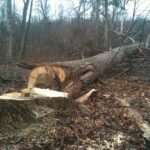As a desert-dweller turned Garden State resident, I have learned the ins and outs of gardening as an adult. Failures, wonder, sweat, tears, disgust, and laughter have all characterized moments of my own growth alongside my garden. I’m a fairly decent amateur gardener now, with an annual pumpkin patch, several large flower gardens and fields, several small orchards of fruit trees. A potager garden lines my front entryway, blurring the distinction between nature and habitation as the herbs planted there season our food year-round. My garden has taught me many lessons over the years, but perhaps the most difficult lesson I have been learning comes through pruning.
Part of what is so hard about pruning is that sometimes the effort to get a single sprout is immense, maybe years of planting in different places, trying different seeds, absorbing different weather. By the time an actual plant or tree sprouts and continues to grow, I am tempted to leave well enough alone. To some extent, nature takes care of excess. Our white pine trees, for example, self-prune. Large branches on the lower canopies break and fall in the wind, mercifully releasing me from the decision-making about which branches should go. Other times, lack of space renders an overcrowded patch fruitful as the stronger plants overtake weaker ones that are competing for nutrients. Sometimes even pests like voles prune for us, albeit destructively; they over-prune, indiscriminately cutting crops down too far, as the vermin compete to eat their weight in vegetables every day.
But for the most part, pruning is an act of will that the gardener must undertake with wisdom and artistry.
Years ago when we moved into our home in late summer, our girls collected buckets full of ripe apples that colored our landscape and gave them to the movers hauling in boxes. To our delight, we discovered more fruit in our yard: blackberries, grapes, pears, persimmons! Several apple and pear trees were clustered together, the benefit of the previous owners’ cultivation. We knew little about growing and tending trees, especially fruit trees, when we arrived. We ate pear after pear, made fresh fruit crisps that we shared with our friendly, elderly neighbors and had so much excess, my answer to the kids’ “Can I eat an apple?” was a nonchalant, carefree “Sure,” even if the toddler only took two bites before tossing it to the compost.
However, by the next summer, one of our pear trees had died. Looking back, I’m not certain what killed it. That death made us look closer at the fruit trees, noticing that, in fact, none of them looked quite healthy. Noticeably fewer fruits were growing on the branches. I started to feel foolish and embarrassed. For the first time in our lives, we had this incredible yard and had been the beneficiaries of previous residents who had cultivated fruit trees and hedges, but we had never before had the responsibility of caring for trees. I guess I had assumed trees grew with little cultivation, as a forest seemingly does.
The fruit trees and others in our yard seemed to be crying out for something. But what?
I scheduled an estimate by a tree care service. The hippy-looking man meandered slowly around the property, expertly identifying the types of trees and speaking with me as if I too shared his arboreal language. Channeling the academic look of appearing to understand all even while at quite an intellectual disadvantage on a lesser-known subject, I nodded along. He said he’d send an estimate with a plan to revive these trees.
The initial shock of his estimate was the price. I have since learned that any company with the title “Princeton” in it will probably be expensive. Upon closer examination, the enduring shock was that the main service needed was pruning. On a four-page document, the recommendation of pruning appeared 30 times. Over and over, 16 times in fact, the service plan recommended “center prune for optimal health.” Additional instructions were to prune away from other obstructions like utility lines, gutters, and neighboring plants. Prune away the dead branches. Weed the base of the trees.
On the one hand, the recommendations seemed simple. Was pruning really the main treatment to nurse the trees back to health? I checked out books from the library and started reading. I also started pruning. I discovered that pruning apple and pear trees was as much art as science. To begin, one had to have a basic understanding the tree’s lifecycle and a knowledge of its parts.
Once a gardener understood these basic scientific cycles, the principles for pruning appeared: prune at certain seasons, enable one leader, ensure lower branches form a canopy and do not cover each other, allow equal sunlight to reach all remaining branches, prune dead branches, prune diseased branches. These principles leave much up to the individual gardener’s judgment. The goal is to create a healthy tree growing in the right places, but which branches to prune are largely a matter of artistry.
There are some parts of the tree that a gardener should almost always prune. One category is a dead branch. This is a branch that is old and spent. Hopefully it had a good life, but its time on the tree is done. Some areas of life were fruitful for a season, but their time, like a dead branch, has passed.
Another branch to prune is a diseased branch. A diseased branch may have been healthy and even in the right place but is stricken, either from without or from within, by disease. Areas of life can be this way too. An endeavor, a relationship, a goal may have been good for a time. Whether it starts to rot from the inside or from an external pestilence, leaving it on the tree threatens the life of the tree itself. Diseased branches can be particularly troubling as the extent of its damage may require time to uncover and may necessitate additional pruning to clear the rot.
Perhaps the most common type of branch to prune is a branch that is in the wrong place. This can be a tree sucker, a branch that sticks straight up from the root system of the tree near the ground and siphons nutrients away from the central tree’s systems. A sucker is an obvious cut. Other branches in the wrong place are those that grow into an obstruction like electric lines or gutters, also relatively easy to see and trim away, once we stop to observe.
A competing leader is strong branch in the wrong place, attempting to overtake the existing, central leader. Last year, I noticed a competing leader growing on one of the pear trees. In hindsight, the necessary pruning should have been obvious. We had not had many pears from this tree for a few years. The pears the tree did produce were small and frequently rotted on the branch before ripening. One year I blamed the crows, the next year the squirrels. The causal problem was a competing leader. A fruit tree should have one leader, a strong central branch reaching up from the trunk of the tree. From this branch, smaller branches branch out horizontally, and when pruned well, have good and relatively equal access to sunshine and nutrients in their own growing spaces. Sometimes, one of the nearby branches shoots straight up alongside the leader, growing thick and tall, competing with the leader to direct the tree’s growth.
Competing leaders take away nutrients from the tree and threaten its fruitfulness. I knew this, but by the time I noticed this particular competing leader on my pear tree, it was quite big. I worried that cutting it might even kill the tree. The longer I waited to prune, the worse the problem would get. Additionally, the longer I waited to prune, the more physically challenging cutting that leader would be. Sawing thick branches is an endurance and patience building endeavor. Saving me the physical exertion, my husband asked if any branches needed clipping, and I pointed with trepidation to the competing leader. He sawed. The competing leader fell.
Through that next spring, I watched the pear tree and was surprised at how many buds it had. Through the summer, small fruits grew. By fall, we had more pears on that tree than any year since our first year here. The pears fully ripened on the branches and were juicy, sweet, delicious, enormous. Again, we had excess to the extent that the children always received a “yes” from me when they asked to munch pears for a snack. The pruning that I feared would kill the tree turned out to be the instrument of its flourishing.
Another difficult branch to prune is a healthy branch that is overcrowded. This is perhaps the most difficult branch to prune because the gardener must step back and look at the shape of the entire tree to determine which of the existing, seemingly healthy branches should go. It is hard to cut away branches that are growing, but we need not wait until they are diseased or dying to prune them. The tree, as the tree care service reminded me, needs constant pruning to stay healthy.
Not all carers of a tree would prune the exact same branches. They have to have a vision for the whole tree. In cases of overcrowding, there is not one clear branch to cut. Which ones the gardener chooses are a matter of allowing the remaining branches optimal nutrients for flourishing. So each of us has a vision for our own trees of life. Not only is it okay that we prune off some branches that others wouldn’t—it is an impossibility that any two trees, branches, and caretakers of the orchard would shape trees into identical twins. This reminds us to be gracious in evaluating how others do their own pruning and expectant of the beauty and wonder that surprises us when we meet the vision of a different artist.
Pruning is difficult because we are forced to make a conscious decision to remove something that has been part of a growing plant. But these cuts are necessary and even life-giving. Like plants and trees, we are finite. Our efforts and time and emotions cannot tend to every endeavor across the earth, or even across the physical communities which we inhabit. We have to choose which branches to give our energies to and which ones must go.
Our pruning choices will not be identical to those around us, but these differences contribute to beauty in the way a bouquet of flowers awes us with diverse and vibrant varieties of plants next to each other, lovely in themselves and even more exquisite when gathered together. Even well-tended trees growing in a fruit orchard require pollen from neighboring trees to grow and bear fruit. Like self-unfruitful trees, our growth is enmeshed in a larger habitat dependent on ordered others. Wisely and regularly cutting away the dead, diseased, and overcrowded areas in our lives, and being in the company of others taking similar actions, yields healthy fruit.
Image Credit: Thomas Cole, “The Garden of Eden” (1828) via Collections-GetArchive






1 comment
Peter Webb
So Beautifully written; this challenge of choice and vision. I love learning from pruning and you do such a great job of succinctly taking us through the steps and some reflections on profound realities which simplicity and analogy tease us with.
Thanks , Regards Pete
Comments are closed.